Business Environment Report: Morrisons, Macro & Micro Analysis
VerifiedAdded on 2020/12/10
|14
|3198
|376
Report
AI Summary
This report delves into the multifaceted aspects of the business environment, encompassing an in-depth analysis of public, private, and voluntary sectors. It meticulously examines the distinct purposes and characteristics of each sector, highlighting their operational differences and contributions. The report further explores stakeholder mapping, focusing on the objectives of key stakeholders such as shareholders, employees, and customers, and how these objectives influence corporate strategies. Additionally, it applies macro and micro environmental analysis techniques, including Pestle analysis and Porter's Five Forces, to assess the external factors impacting a specific company, Morrisons. The report provides a comprehensive understanding of how various environmental factors affect business decisions, strategies, and overall performance, offering insights into the complexities of the business landscape.
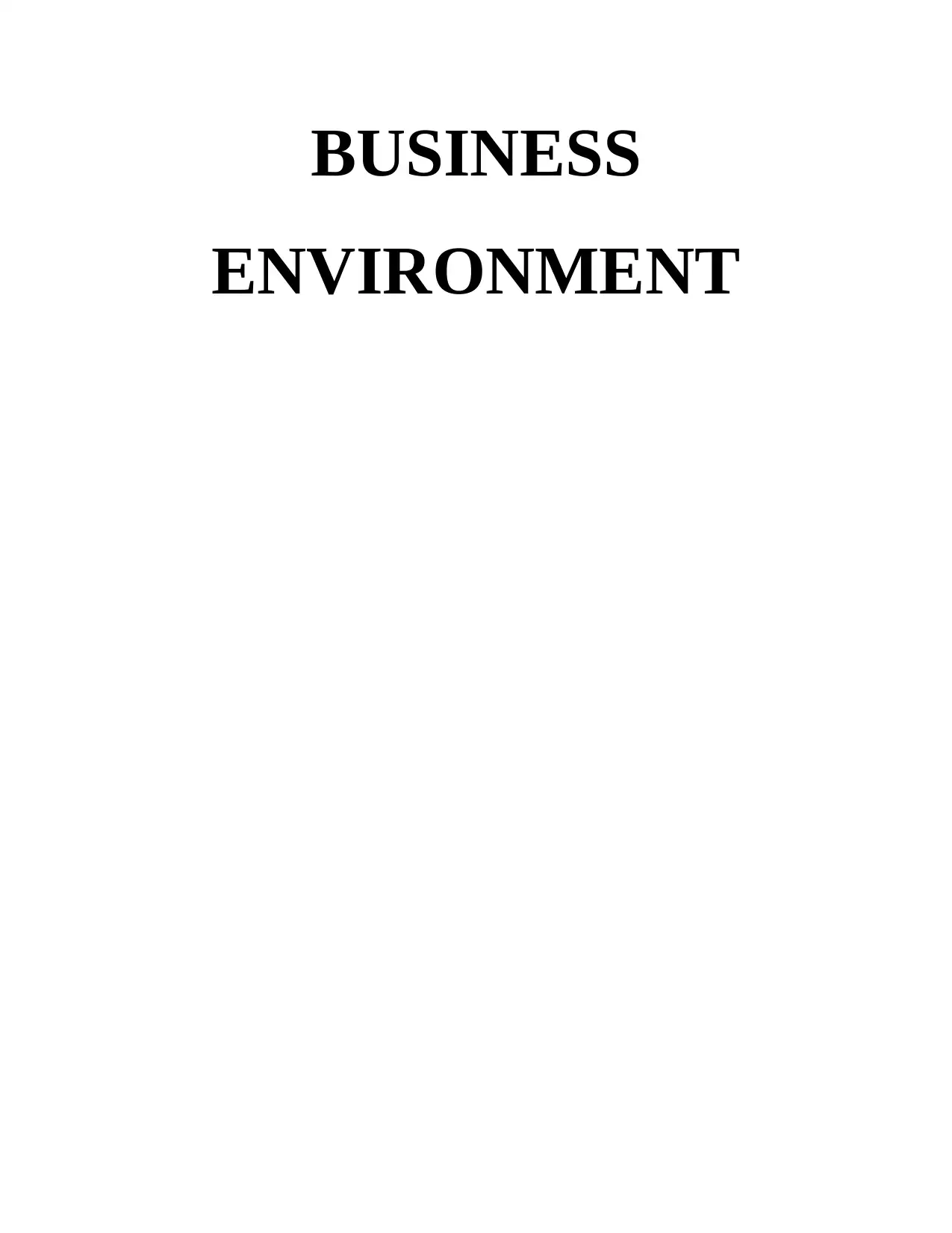
BUSINESS
ENVIRONMENT
ENVIRONMENT
Paraphrase This Document
Need a fresh take? Get an instant paraphrase of this document with our AI Paraphraser
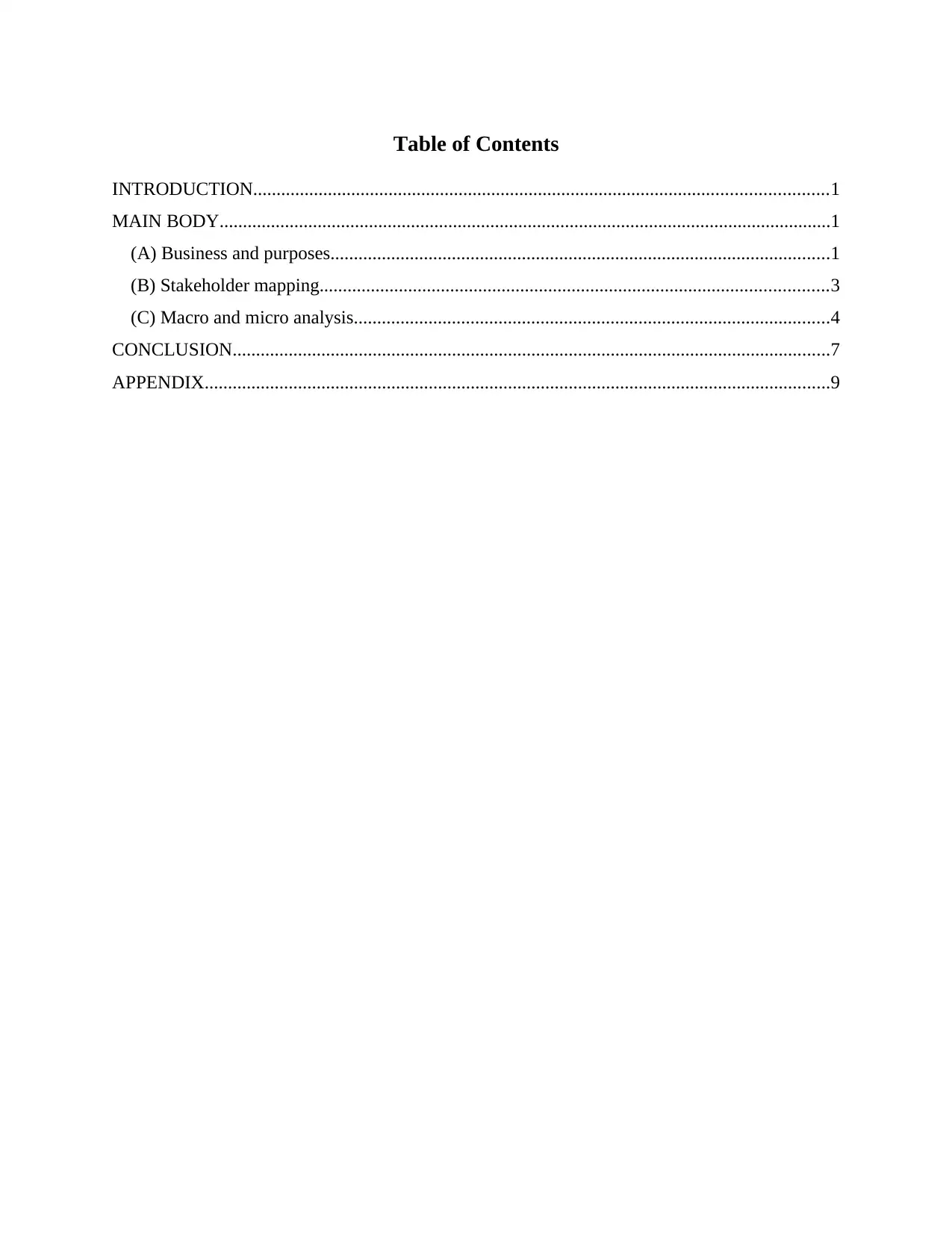
Table of Contents
INTRODUCTION...........................................................................................................................1
MAIN BODY...................................................................................................................................1
(A) Business and purposes...........................................................................................................1
(B) Stakeholder mapping.............................................................................................................3
(C) Macro and micro analysis......................................................................................................4
CONCLUSION................................................................................................................................7
APPENDIX......................................................................................................................................9
INTRODUCTION...........................................................................................................................1
MAIN BODY...................................................................................................................................1
(A) Business and purposes...........................................................................................................1
(B) Stakeholder mapping.............................................................................................................3
(C) Macro and micro analysis......................................................................................................4
CONCLUSION................................................................................................................................7
APPENDIX......................................................................................................................................9

⊘ This is a preview!⊘
Do you want full access?
Subscribe today to unlock all pages.

Trusted by 1+ million students worldwide
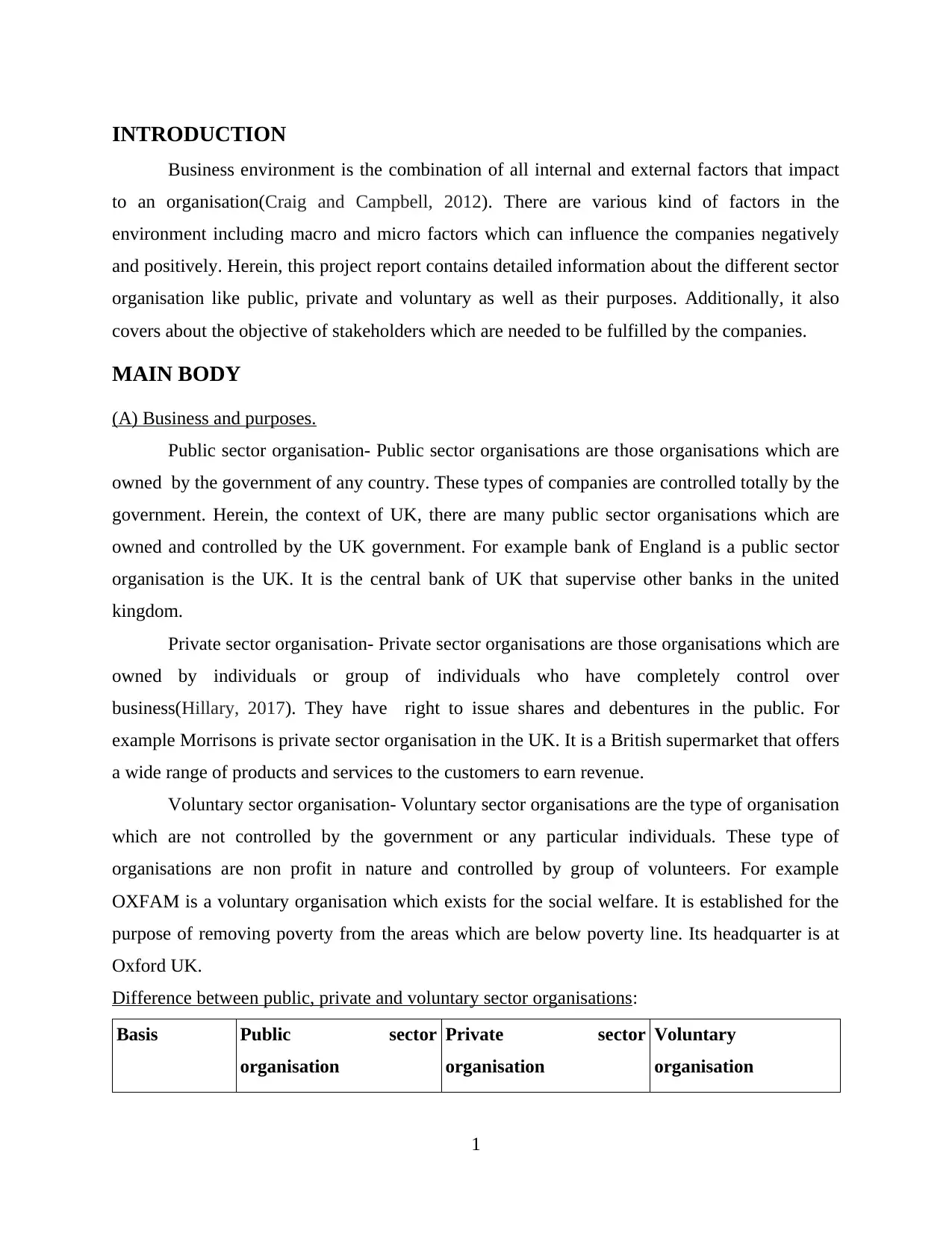
INTRODUCTION
Business environment is the combination of all internal and external factors that impact
to an organisation(Craig and Campbell, 2012). There are various kind of factors in the
environment including macro and micro factors which can influence the companies negatively
and positively. Herein, this project report contains detailed information about the different sector
organisation like public, private and voluntary as well as their purposes. Additionally, it also
covers about the objective of stakeholders which are needed to be fulfilled by the companies.
MAIN BODY
(A) Business and purposes.
Public sector organisation- Public sector organisations are those organisations which are
owned by the government of any country. These types of companies are controlled totally by the
government. Herein, the context of UK, there are many public sector organisations which are
owned and controlled by the UK government. For example bank of England is a public sector
organisation is the UK. It is the central bank of UK that supervise other banks in the united
kingdom.
Private sector organisation- Private sector organisations are those organisations which are
owned by individuals or group of individuals who have completely control over
business(Hillary, 2017). They have right to issue shares and debentures in the public. For
example Morrisons is private sector organisation in the UK. It is a British supermarket that offers
a wide range of products and services to the customers to earn revenue.
Voluntary sector organisation- Voluntary sector organisations are the type of organisation
which are not controlled by the government or any particular individuals. These type of
organisations are non profit in nature and controlled by group of volunteers. For example
OXFAM is a voluntary organisation which exists for the social welfare. It is established for the
purpose of removing poverty from the areas which are below poverty line. Its headquarter is at
Oxford UK.
Difference between public, private and voluntary sector organisations:
Basis Public sector
organisation
Private sector
organisation
Voluntary
organisation
1
Business environment is the combination of all internal and external factors that impact
to an organisation(Craig and Campbell, 2012). There are various kind of factors in the
environment including macro and micro factors which can influence the companies negatively
and positively. Herein, this project report contains detailed information about the different sector
organisation like public, private and voluntary as well as their purposes. Additionally, it also
covers about the objective of stakeholders which are needed to be fulfilled by the companies.
MAIN BODY
(A) Business and purposes.
Public sector organisation- Public sector organisations are those organisations which are
owned by the government of any country. These types of companies are controlled totally by the
government. Herein, the context of UK, there are many public sector organisations which are
owned and controlled by the UK government. For example bank of England is a public sector
organisation is the UK. It is the central bank of UK that supervise other banks in the united
kingdom.
Private sector organisation- Private sector organisations are those organisations which are
owned by individuals or group of individuals who have completely control over
business(Hillary, 2017). They have right to issue shares and debentures in the public. For
example Morrisons is private sector organisation in the UK. It is a British supermarket that offers
a wide range of products and services to the customers to earn revenue.
Voluntary sector organisation- Voluntary sector organisations are the type of organisation
which are not controlled by the government or any particular individuals. These type of
organisations are non profit in nature and controlled by group of volunteers. For example
OXFAM is a voluntary organisation which exists for the social welfare. It is established for the
purpose of removing poverty from the areas which are below poverty line. Its headquarter is at
Oxford UK.
Difference between public, private and voluntary sector organisations:
Basis Public sector
organisation
Private sector
organisation
Voluntary
organisation
1
Paraphrase This Document
Need a fresh take? Get an instant paraphrase of this document with our AI Paraphraser
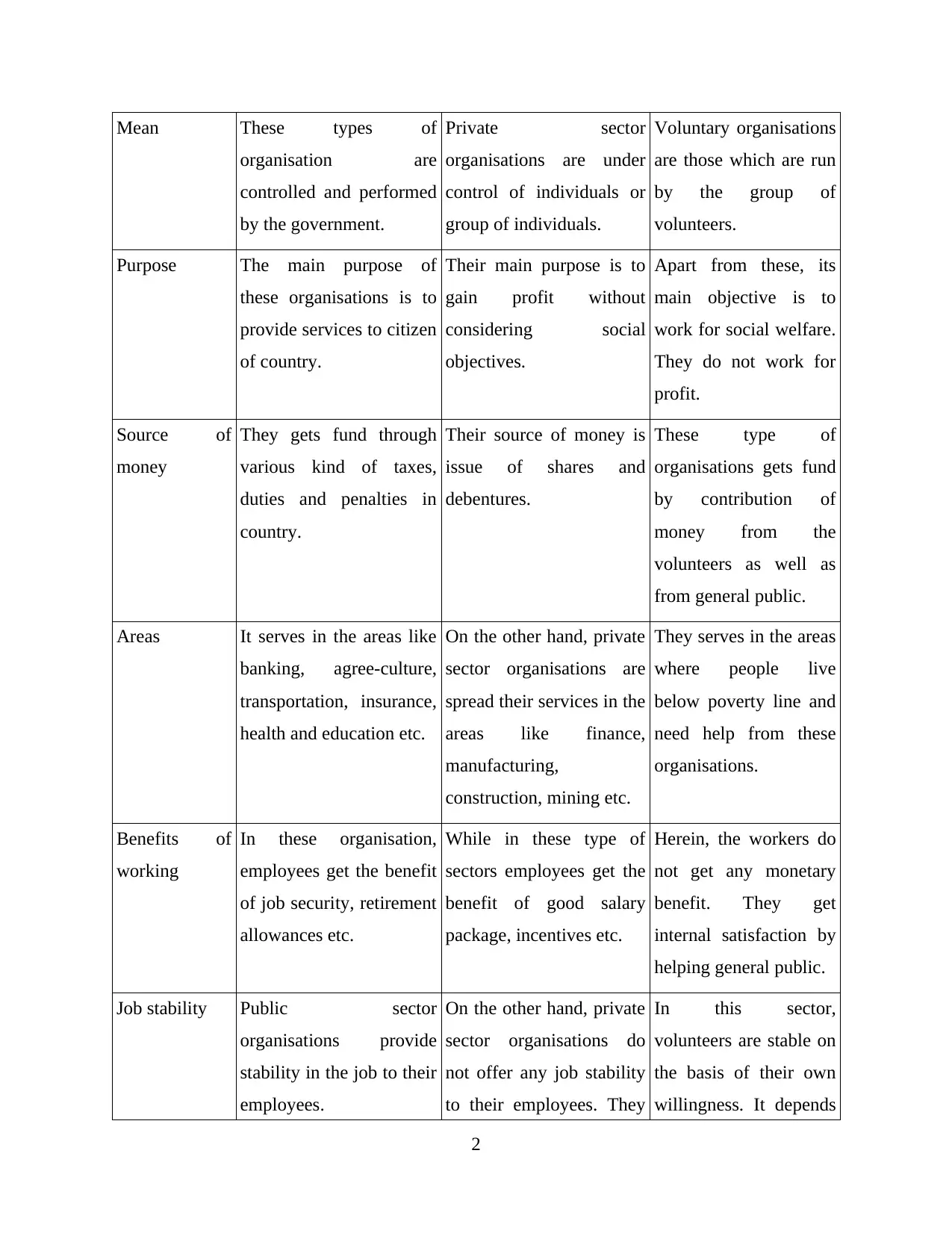
Mean These types of
organisation are
controlled and performed
by the government.
Private sector
organisations are under
control of individuals or
group of individuals.
Voluntary organisations
are those which are run
by the group of
volunteers.
Purpose The main purpose of
these organisations is to
provide services to citizen
of country.
Their main purpose is to
gain profit without
considering social
objectives.
Apart from these, its
main objective is to
work for social welfare.
They do not work for
profit.
Source of
money
They gets fund through
various kind of taxes,
duties and penalties in
country.
Their source of money is
issue of shares and
debentures.
These type of
organisations gets fund
by contribution of
money from the
volunteers as well as
from general public.
Areas It serves in the areas like
banking, agree-culture,
transportation, insurance,
health and education etc.
On the other hand, private
sector organisations are
spread their services in the
areas like finance,
manufacturing,
construction, mining etc.
They serves in the areas
where people live
below poverty line and
need help from these
organisations.
Benefits of
working
In these organisation,
employees get the benefit
of job security, retirement
allowances etc.
While in these type of
sectors employees get the
benefit of good salary
package, incentives etc.
Herein, the workers do
not get any monetary
benefit. They get
internal satisfaction by
helping general public.
Job stability Public sector
organisations provide
stability in the job to their
employees.
On the other hand, private
sector organisations do
not offer any job stability
to their employees. They
In this sector,
volunteers are stable on
the basis of their own
willingness. It depends
2
organisation are
controlled and performed
by the government.
Private sector
organisations are under
control of individuals or
group of individuals.
Voluntary organisations
are those which are run
by the group of
volunteers.
Purpose The main purpose of
these organisations is to
provide services to citizen
of country.
Their main purpose is to
gain profit without
considering social
objectives.
Apart from these, its
main objective is to
work for social welfare.
They do not work for
profit.
Source of
money
They gets fund through
various kind of taxes,
duties and penalties in
country.
Their source of money is
issue of shares and
debentures.
These type of
organisations gets fund
by contribution of
money from the
volunteers as well as
from general public.
Areas It serves in the areas like
banking, agree-culture,
transportation, insurance,
health and education etc.
On the other hand, private
sector organisations are
spread their services in the
areas like finance,
manufacturing,
construction, mining etc.
They serves in the areas
where people live
below poverty line and
need help from these
organisations.
Benefits of
working
In these organisation,
employees get the benefit
of job security, retirement
allowances etc.
While in these type of
sectors employees get the
benefit of good salary
package, incentives etc.
Herein, the workers do
not get any monetary
benefit. They get
internal satisfaction by
helping general public.
Job stability Public sector
organisations provide
stability in the job to their
employees.
On the other hand, private
sector organisations do
not offer any job stability
to their employees. They
In this sector,
volunteers are stable on
the basis of their own
willingness. It depends
2
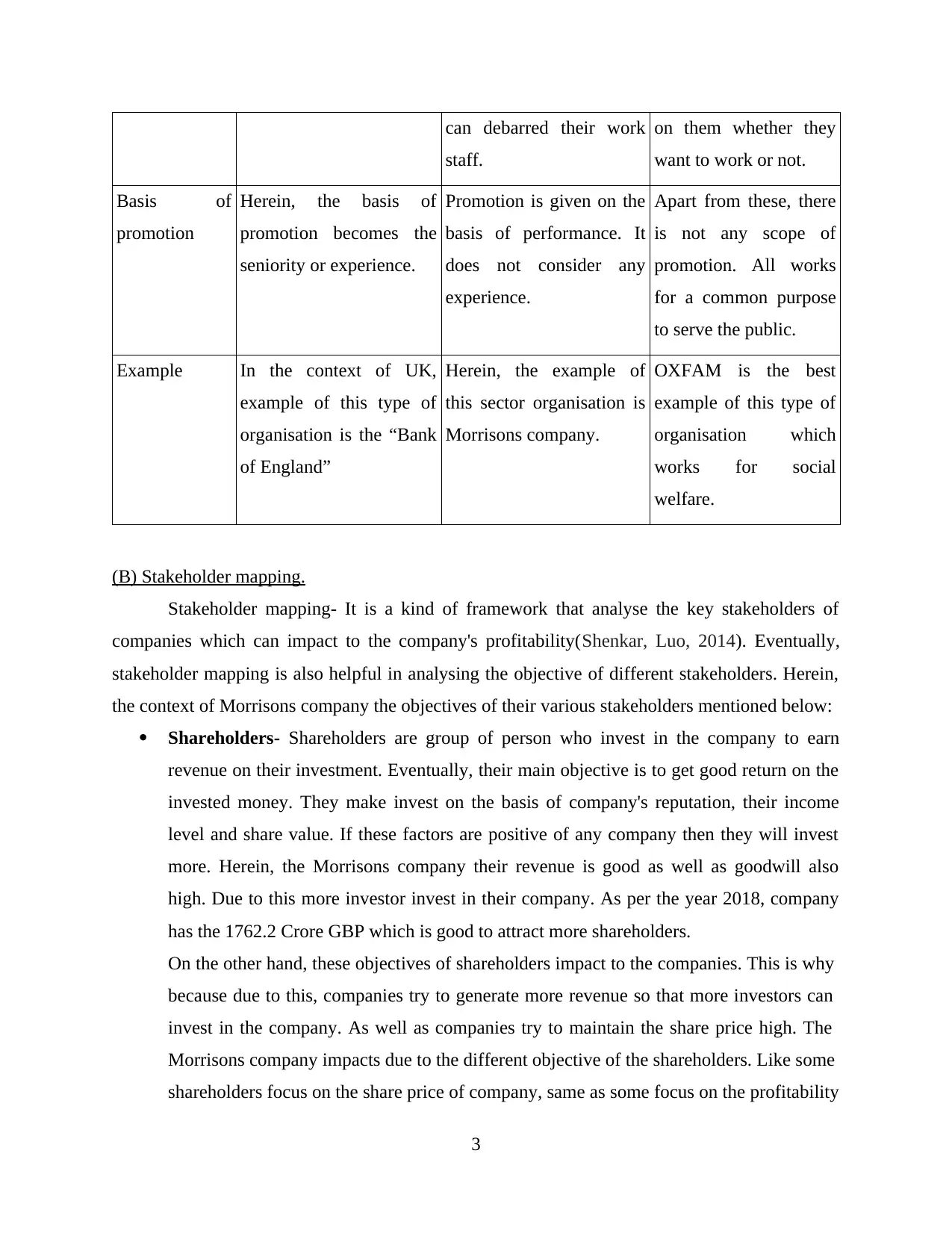
can debarred their work
staff.
on them whether they
want to work or not.
Basis of
promotion
Herein, the basis of
promotion becomes the
seniority or experience.
Promotion is given on the
basis of performance. It
does not consider any
experience.
Apart from these, there
is not any scope of
promotion. All works
for a common purpose
to serve the public.
Example In the context of UK,
example of this type of
organisation is the “Bank
of England”
Herein, the example of
this sector organisation is
Morrisons company.
OXFAM is the best
example of this type of
organisation which
works for social
welfare.
(B) Stakeholder mapping.
Stakeholder mapping- It is a kind of framework that analyse the key stakeholders of
companies which can impact to the company's profitability(Shenkar, Luo, 2014). Eventually,
stakeholder mapping is also helpful in analysing the objective of different stakeholders. Herein,
the context of Morrisons company the objectives of their various stakeholders mentioned below:
Shareholders- Shareholders are group of person who invest in the company to earn
revenue on their investment. Eventually, their main objective is to get good return on the
invested money. They make invest on the basis of company's reputation, their income
level and share value. If these factors are positive of any company then they will invest
more. Herein, the Morrisons company their revenue is good as well as goodwill also
high. Due to this more investor invest in their company. As per the year 2018, company
has the 1762.2 Crore GBP which is good to attract more shareholders.
On the other hand, these objectives of shareholders impact to the companies. This is why
because due to this, companies try to generate more revenue so that more investors can
invest in the company. As well as companies try to maintain the share price high. The
Morrisons company impacts due to the different objective of the shareholders. Like some
shareholders focus on the share price of company, same as some focus on the profitability
3
staff.
on them whether they
want to work or not.
Basis of
promotion
Herein, the basis of
promotion becomes the
seniority or experience.
Promotion is given on the
basis of performance. It
does not consider any
experience.
Apart from these, there
is not any scope of
promotion. All works
for a common purpose
to serve the public.
Example In the context of UK,
example of this type of
organisation is the “Bank
of England”
Herein, the example of
this sector organisation is
Morrisons company.
OXFAM is the best
example of this type of
organisation which
works for social
welfare.
(B) Stakeholder mapping.
Stakeholder mapping- It is a kind of framework that analyse the key stakeholders of
companies which can impact to the company's profitability(Shenkar, Luo, 2014). Eventually,
stakeholder mapping is also helpful in analysing the objective of different stakeholders. Herein,
the context of Morrisons company the objectives of their various stakeholders mentioned below:
Shareholders- Shareholders are group of person who invest in the company to earn
revenue on their investment. Eventually, their main objective is to get good return on the
invested money. They make invest on the basis of company's reputation, their income
level and share value. If these factors are positive of any company then they will invest
more. Herein, the Morrisons company their revenue is good as well as goodwill also
high. Due to this more investor invest in their company. As per the year 2018, company
has the 1762.2 Crore GBP which is good to attract more shareholders.
On the other hand, these objectives of shareholders impact to the companies. This is why
because due to this, companies try to generate more revenue so that more investors can
invest in the company. As well as companies try to maintain the share price high. The
Morrisons company impacts due to the different objective of the shareholders. Like some
shareholders focus on the share price of company, same as some focus on the profitability
3
⊘ This is a preview!⊘
Do you want full access?
Subscribe today to unlock all pages.

Trusted by 1+ million students worldwide
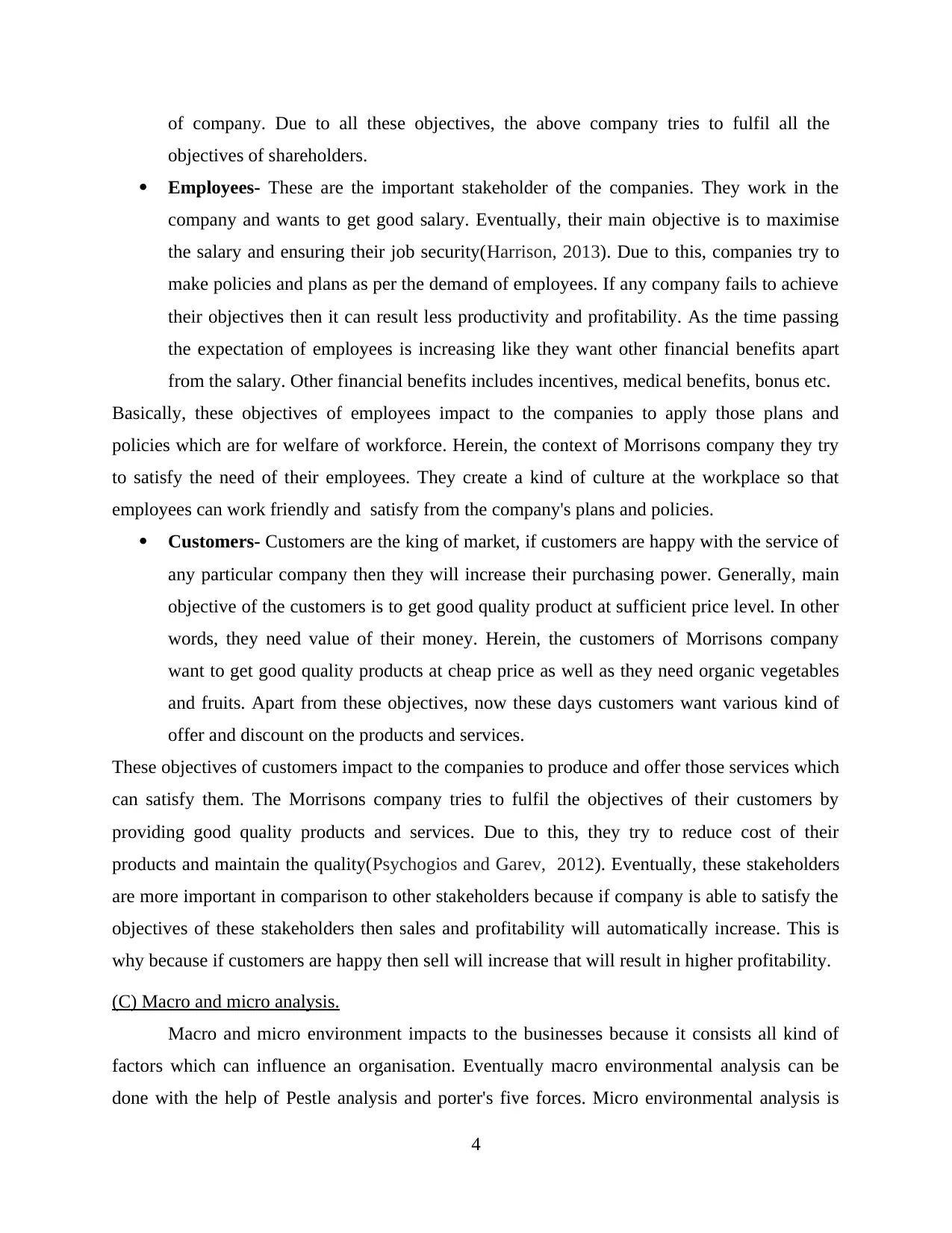
of company. Due to all these objectives, the above company tries to fulfil all the
objectives of shareholders.
Employees- These are the important stakeholder of the companies. They work in the
company and wants to get good salary. Eventually, their main objective is to maximise
the salary and ensuring their job security(Harrison, 2013). Due to this, companies try to
make policies and plans as per the demand of employees. If any company fails to achieve
their objectives then it can result less productivity and profitability. As the time passing
the expectation of employees is increasing like they want other financial benefits apart
from the salary. Other financial benefits includes incentives, medical benefits, bonus etc.
Basically, these objectives of employees impact to the companies to apply those plans and
policies which are for welfare of workforce. Herein, the context of Morrisons company they try
to satisfy the need of their employees. They create a kind of culture at the workplace so that
employees can work friendly and satisfy from the company's plans and policies.
Customers- Customers are the king of market, if customers are happy with the service of
any particular company then they will increase their purchasing power. Generally, main
objective of the customers is to get good quality product at sufficient price level. In other
words, they need value of their money. Herein, the customers of Morrisons company
want to get good quality products at cheap price as well as they need organic vegetables
and fruits. Apart from these objectives, now these days customers want various kind of
offer and discount on the products and services.
These objectives of customers impact to the companies to produce and offer those services which
can satisfy them. The Morrisons company tries to fulfil the objectives of their customers by
providing good quality products and services. Due to this, they try to reduce cost of their
products and maintain the quality(Psychogios and Garev, 2012). Eventually, these stakeholders
are more important in comparison to other stakeholders because if company is able to satisfy the
objectives of these stakeholders then sales and profitability will automatically increase. This is
why because if customers are happy then sell will increase that will result in higher profitability.
(C) Macro and micro analysis.
Macro and micro environment impacts to the businesses because it consists all kind of
factors which can influence an organisation. Eventually macro environmental analysis can be
done with the help of Pestle analysis and porter's five forces. Micro environmental analysis is
4
objectives of shareholders.
Employees- These are the important stakeholder of the companies. They work in the
company and wants to get good salary. Eventually, their main objective is to maximise
the salary and ensuring their job security(Harrison, 2013). Due to this, companies try to
make policies and plans as per the demand of employees. If any company fails to achieve
their objectives then it can result less productivity and profitability. As the time passing
the expectation of employees is increasing like they want other financial benefits apart
from the salary. Other financial benefits includes incentives, medical benefits, bonus etc.
Basically, these objectives of employees impact to the companies to apply those plans and
policies which are for welfare of workforce. Herein, the context of Morrisons company they try
to satisfy the need of their employees. They create a kind of culture at the workplace so that
employees can work friendly and satisfy from the company's plans and policies.
Customers- Customers are the king of market, if customers are happy with the service of
any particular company then they will increase their purchasing power. Generally, main
objective of the customers is to get good quality product at sufficient price level. In other
words, they need value of their money. Herein, the customers of Morrisons company
want to get good quality products at cheap price as well as they need organic vegetables
and fruits. Apart from these objectives, now these days customers want various kind of
offer and discount on the products and services.
These objectives of customers impact to the companies to produce and offer those services which
can satisfy them. The Morrisons company tries to fulfil the objectives of their customers by
providing good quality products and services. Due to this, they try to reduce cost of their
products and maintain the quality(Psychogios and Garev, 2012). Eventually, these stakeholders
are more important in comparison to other stakeholders because if company is able to satisfy the
objectives of these stakeholders then sales and profitability will automatically increase. This is
why because if customers are happy then sell will increase that will result in higher profitability.
(C) Macro and micro analysis.
Macro and micro environment impacts to the businesses because it consists all kind of
factors which can influence an organisation. Eventually macro environmental analysis can be
done with the help of Pestle analysis and porter's five forces. Micro environmental analysis is
4
Paraphrase This Document
Need a fresh take? Get an instant paraphrase of this document with our AI Paraphraser
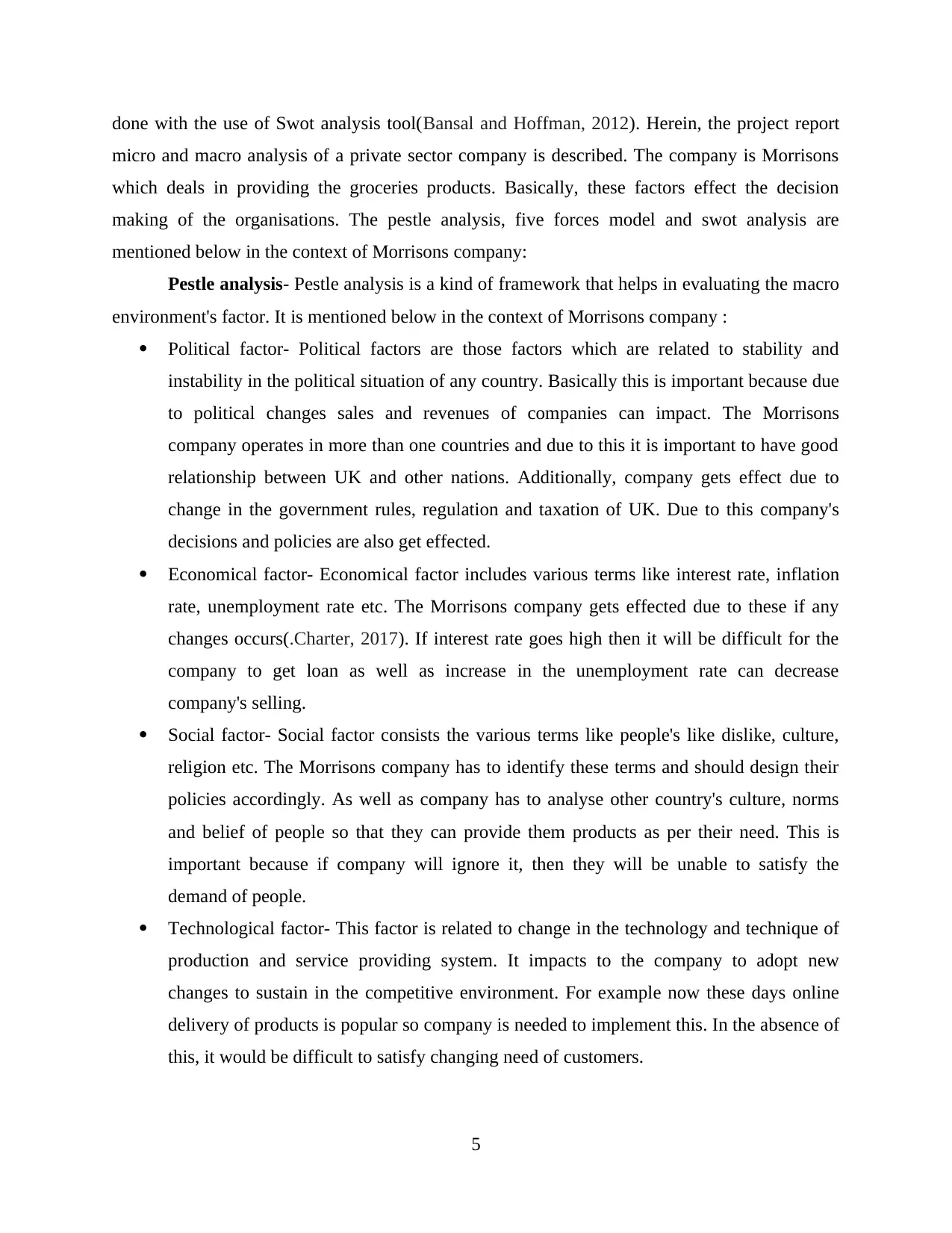
done with the use of Swot analysis tool(Bansal and Hoffman, 2012). Herein, the project report
micro and macro analysis of a private sector company is described. The company is Morrisons
which deals in providing the groceries products. Basically, these factors effect the decision
making of the organisations. The pestle analysis, five forces model and swot analysis are
mentioned below in the context of Morrisons company:
Pestle analysis- Pestle analysis is a kind of framework that helps in evaluating the macro
environment's factor. It is mentioned below in the context of Morrisons company :
Political factor- Political factors are those factors which are related to stability and
instability in the political situation of any country. Basically this is important because due
to political changes sales and revenues of companies can impact. The Morrisons
company operates in more than one countries and due to this it is important to have good
relationship between UK and other nations. Additionally, company gets effect due to
change in the government rules, regulation and taxation of UK. Due to this company's
decisions and policies are also get effected.
Economical factor- Economical factor includes various terms like interest rate, inflation
rate, unemployment rate etc. The Morrisons company gets effected due to these if any
changes occurs(.Charter, 2017). If interest rate goes high then it will be difficult for the
company to get loan as well as increase in the unemployment rate can decrease
company's selling.
Social factor- Social factor consists the various terms like people's like dislike, culture,
religion etc. The Morrisons company has to identify these terms and should design their
policies accordingly. As well as company has to analyse other country's culture, norms
and belief of people so that they can provide them products as per their need. This is
important because if company will ignore it, then they will be unable to satisfy the
demand of people.
Technological factor- This factor is related to change in the technology and technique of
production and service providing system. It impacts to the company to adopt new
changes to sustain in the competitive environment. For example now these days online
delivery of products is popular so company is needed to implement this. In the absence of
this, it would be difficult to satisfy changing need of customers.
5
micro and macro analysis of a private sector company is described. The company is Morrisons
which deals in providing the groceries products. Basically, these factors effect the decision
making of the organisations. The pestle analysis, five forces model and swot analysis are
mentioned below in the context of Morrisons company:
Pestle analysis- Pestle analysis is a kind of framework that helps in evaluating the macro
environment's factor. It is mentioned below in the context of Morrisons company :
Political factor- Political factors are those factors which are related to stability and
instability in the political situation of any country. Basically this is important because due
to political changes sales and revenues of companies can impact. The Morrisons
company operates in more than one countries and due to this it is important to have good
relationship between UK and other nations. Additionally, company gets effect due to
change in the government rules, regulation and taxation of UK. Due to this company's
decisions and policies are also get effected.
Economical factor- Economical factor includes various terms like interest rate, inflation
rate, unemployment rate etc. The Morrisons company gets effected due to these if any
changes occurs(.Charter, 2017). If interest rate goes high then it will be difficult for the
company to get loan as well as increase in the unemployment rate can decrease
company's selling.
Social factor- Social factor consists the various terms like people's like dislike, culture,
religion etc. The Morrisons company has to identify these terms and should design their
policies accordingly. As well as company has to analyse other country's culture, norms
and belief of people so that they can provide them products as per their need. This is
important because if company will ignore it, then they will be unable to satisfy the
demand of people.
Technological factor- This factor is related to change in the technology and technique of
production and service providing system. It impacts to the company to adopt new
changes to sustain in the competitive environment. For example now these days online
delivery of products is popular so company is needed to implement this. In the absence of
this, it would be difficult to satisfy changing need of customers.
5
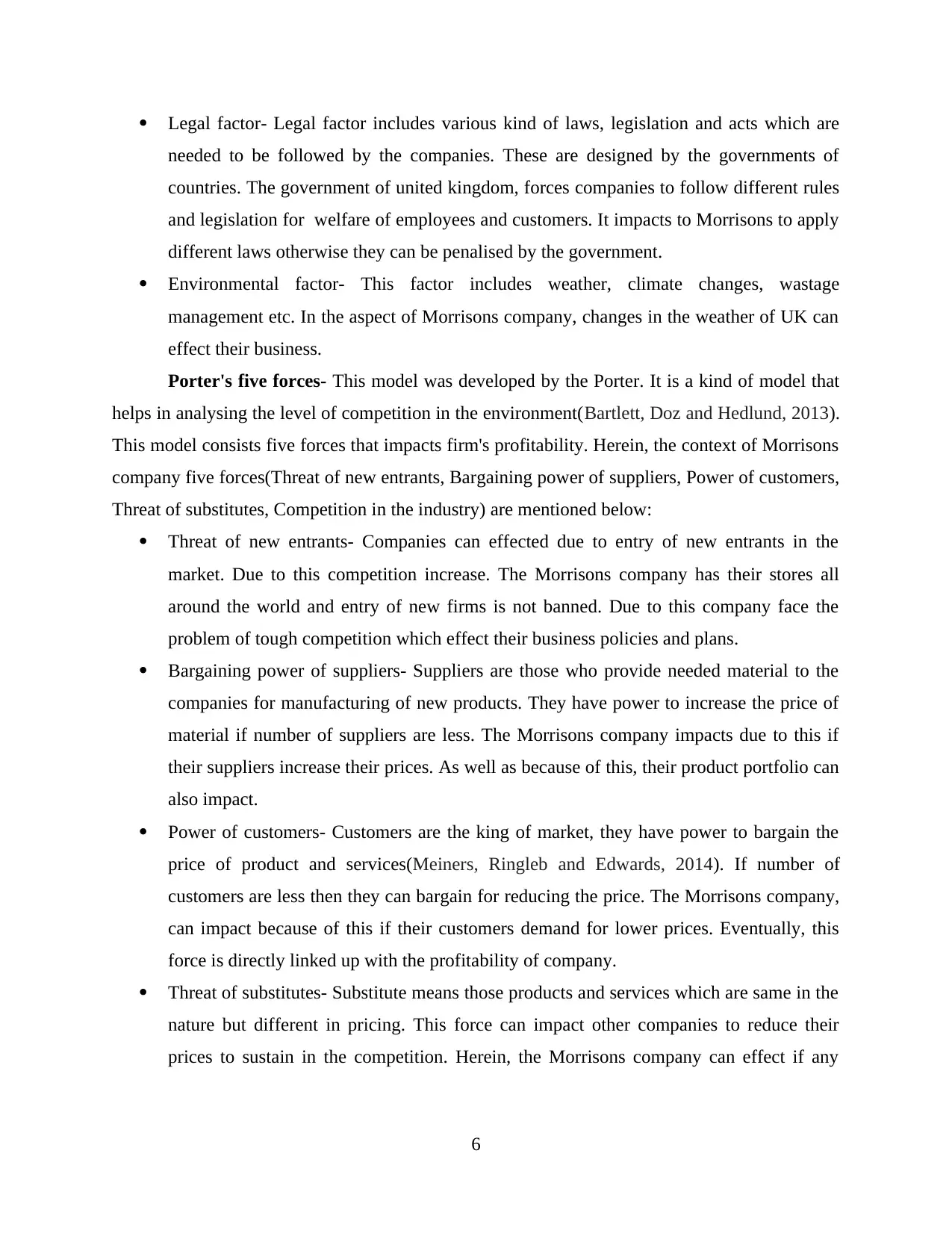
Legal factor- Legal factor includes various kind of laws, legislation and acts which are
needed to be followed by the companies. These are designed by the governments of
countries. The government of united kingdom, forces companies to follow different rules
and legislation for welfare of employees and customers. It impacts to Morrisons to apply
different laws otherwise they can be penalised by the government.
Environmental factor- This factor includes weather, climate changes, wastage
management etc. In the aspect of Morrisons company, changes in the weather of UK can
effect their business.
Porter's five forces- This model was developed by the Porter. It is a kind of model that
helps in analysing the level of competition in the environment(Bartlett, Doz and Hedlund, 2013).
This model consists five forces that impacts firm's profitability. Herein, the context of Morrisons
company five forces(Threat of new entrants, Bargaining power of suppliers, Power of customers,
Threat of substitutes, Competition in the industry) are mentioned below:
Threat of new entrants- Companies can effected due to entry of new entrants in the
market. Due to this competition increase. The Morrisons company has their stores all
around the world and entry of new firms is not banned. Due to this company face the
problem of tough competition which effect their business policies and plans.
Bargaining power of suppliers- Suppliers are those who provide needed material to the
companies for manufacturing of new products. They have power to increase the price of
material if number of suppliers are less. The Morrisons company impacts due to this if
their suppliers increase their prices. As well as because of this, their product portfolio can
also impact.
Power of customers- Customers are the king of market, they have power to bargain the
price of product and services(Meiners, Ringleb and Edwards, 2014). If number of
customers are less then they can bargain for reducing the price. The Morrisons company,
can impact because of this if their customers demand for lower prices. Eventually, this
force is directly linked up with the profitability of company.
Threat of substitutes- Substitute means those products and services which are same in the
nature but different in pricing. This force can impact other companies to reduce their
prices to sustain in the competition. Herein, the Morrisons company can effect if any
6
needed to be followed by the companies. These are designed by the governments of
countries. The government of united kingdom, forces companies to follow different rules
and legislation for welfare of employees and customers. It impacts to Morrisons to apply
different laws otherwise they can be penalised by the government.
Environmental factor- This factor includes weather, climate changes, wastage
management etc. In the aspect of Morrisons company, changes in the weather of UK can
effect their business.
Porter's five forces- This model was developed by the Porter. It is a kind of model that
helps in analysing the level of competition in the environment(Bartlett, Doz and Hedlund, 2013).
This model consists five forces that impacts firm's profitability. Herein, the context of Morrisons
company five forces(Threat of new entrants, Bargaining power of suppliers, Power of customers,
Threat of substitutes, Competition in the industry) are mentioned below:
Threat of new entrants- Companies can effected due to entry of new entrants in the
market. Due to this competition increase. The Morrisons company has their stores all
around the world and entry of new firms is not banned. Due to this company face the
problem of tough competition which effect their business policies and plans.
Bargaining power of suppliers- Suppliers are those who provide needed material to the
companies for manufacturing of new products. They have power to increase the price of
material if number of suppliers are less. The Morrisons company impacts due to this if
their suppliers increase their prices. As well as because of this, their product portfolio can
also impact.
Power of customers- Customers are the king of market, they have power to bargain the
price of product and services(Meiners, Ringleb and Edwards, 2014). If number of
customers are less then they can bargain for reducing the price. The Morrisons company,
can impact because of this if their customers demand for lower prices. Eventually, this
force is directly linked up with the profitability of company.
Threat of substitutes- Substitute means those products and services which are same in the
nature but different in pricing. This force can impact other companies to reduce their
prices to sustain in the competition. Herein, the Morrisons company can effect if any
6
⊘ This is a preview!⊘
Do you want full access?
Subscribe today to unlock all pages.

Trusted by 1+ million students worldwide
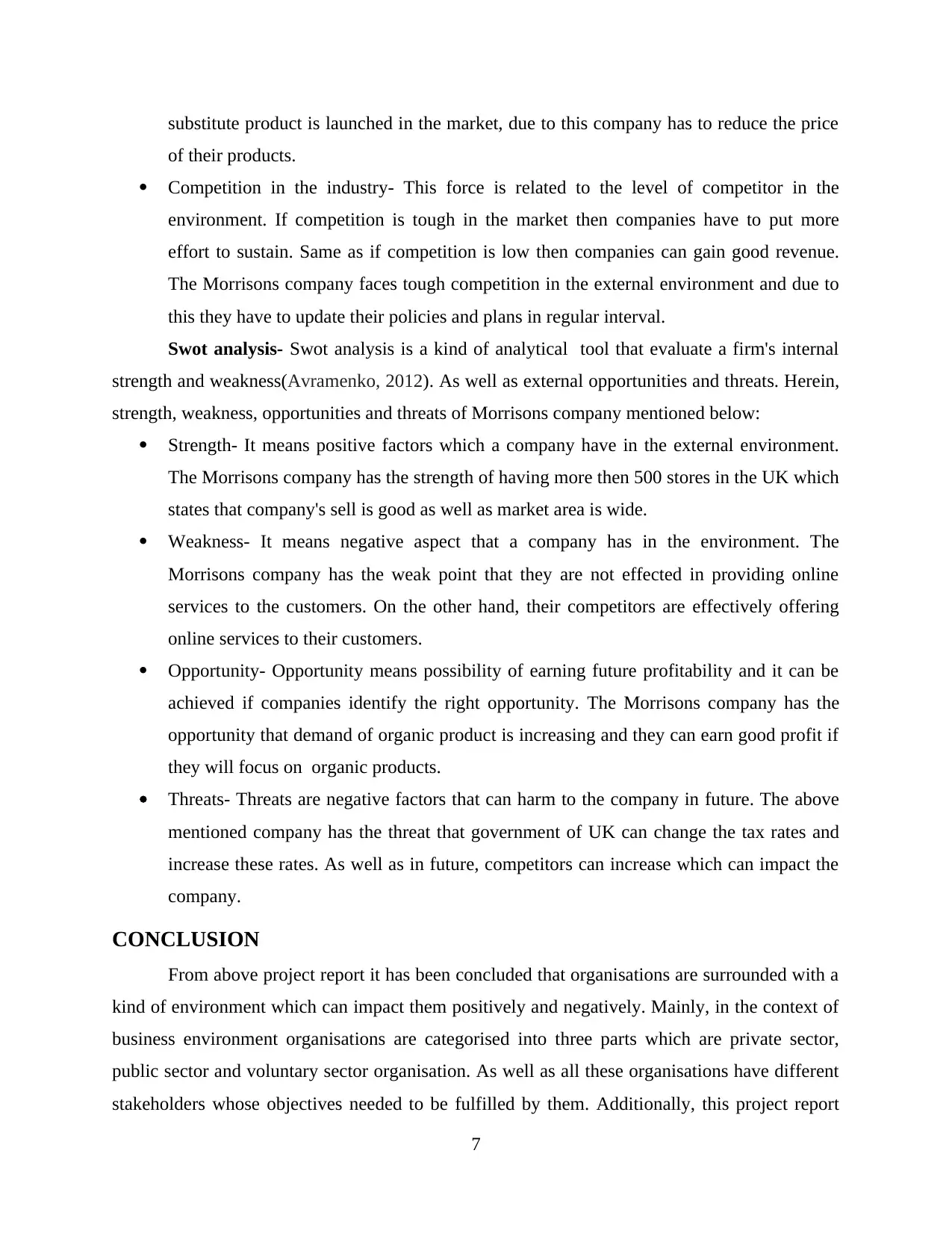
substitute product is launched in the market, due to this company has to reduce the price
of their products.
Competition in the industry- This force is related to the level of competitor in the
environment. If competition is tough in the market then companies have to put more
effort to sustain. Same as if competition is low then companies can gain good revenue.
The Morrisons company faces tough competition in the external environment and due to
this they have to update their policies and plans in regular interval.
Swot analysis- Swot analysis is a kind of analytical tool that evaluate a firm's internal
strength and weakness(Avramenko, 2012). As well as external opportunities and threats. Herein,
strength, weakness, opportunities and threats of Morrisons company mentioned below:
Strength- It means positive factors which a company have in the external environment.
The Morrisons company has the strength of having more then 500 stores in the UK which
states that company's sell is good as well as market area is wide.
Weakness- It means negative aspect that a company has in the environment. The
Morrisons company has the weak point that they are not effected in providing online
services to the customers. On the other hand, their competitors are effectively offering
online services to their customers.
Opportunity- Opportunity means possibility of earning future profitability and it can be
achieved if companies identify the right opportunity. The Morrisons company has the
opportunity that demand of organic product is increasing and they can earn good profit if
they will focus on organic products.
Threats- Threats are negative factors that can harm to the company in future. The above
mentioned company has the threat that government of UK can change the tax rates and
increase these rates. As well as in future, competitors can increase which can impact the
company.
CONCLUSION
From above project report it has been concluded that organisations are surrounded with a
kind of environment which can impact them positively and negatively. Mainly, in the context of
business environment organisations are categorised into three parts which are private sector,
public sector and voluntary sector organisation. As well as all these organisations have different
stakeholders whose objectives needed to be fulfilled by them. Additionally, this project report
7
of their products.
Competition in the industry- This force is related to the level of competitor in the
environment. If competition is tough in the market then companies have to put more
effort to sustain. Same as if competition is low then companies can gain good revenue.
The Morrisons company faces tough competition in the external environment and due to
this they have to update their policies and plans in regular interval.
Swot analysis- Swot analysis is a kind of analytical tool that evaluate a firm's internal
strength and weakness(Avramenko, 2012). As well as external opportunities and threats. Herein,
strength, weakness, opportunities and threats of Morrisons company mentioned below:
Strength- It means positive factors which a company have in the external environment.
The Morrisons company has the strength of having more then 500 stores in the UK which
states that company's sell is good as well as market area is wide.
Weakness- It means negative aspect that a company has in the environment. The
Morrisons company has the weak point that they are not effected in providing online
services to the customers. On the other hand, their competitors are effectively offering
online services to their customers.
Opportunity- Opportunity means possibility of earning future profitability and it can be
achieved if companies identify the right opportunity. The Morrisons company has the
opportunity that demand of organic product is increasing and they can earn good profit if
they will focus on organic products.
Threats- Threats are negative factors that can harm to the company in future. The above
mentioned company has the threat that government of UK can change the tax rates and
increase these rates. As well as in future, competitors can increase which can impact the
company.
CONCLUSION
From above project report it has been concluded that organisations are surrounded with a
kind of environment which can impact them positively and negatively. Mainly, in the context of
business environment organisations are categorised into three parts which are private sector,
public sector and voluntary sector organisation. As well as all these organisations have different
stakeholders whose objectives needed to be fulfilled by them. Additionally, this project report
7
Paraphrase This Document
Need a fresh take? Get an instant paraphrase of this document with our AI Paraphraser
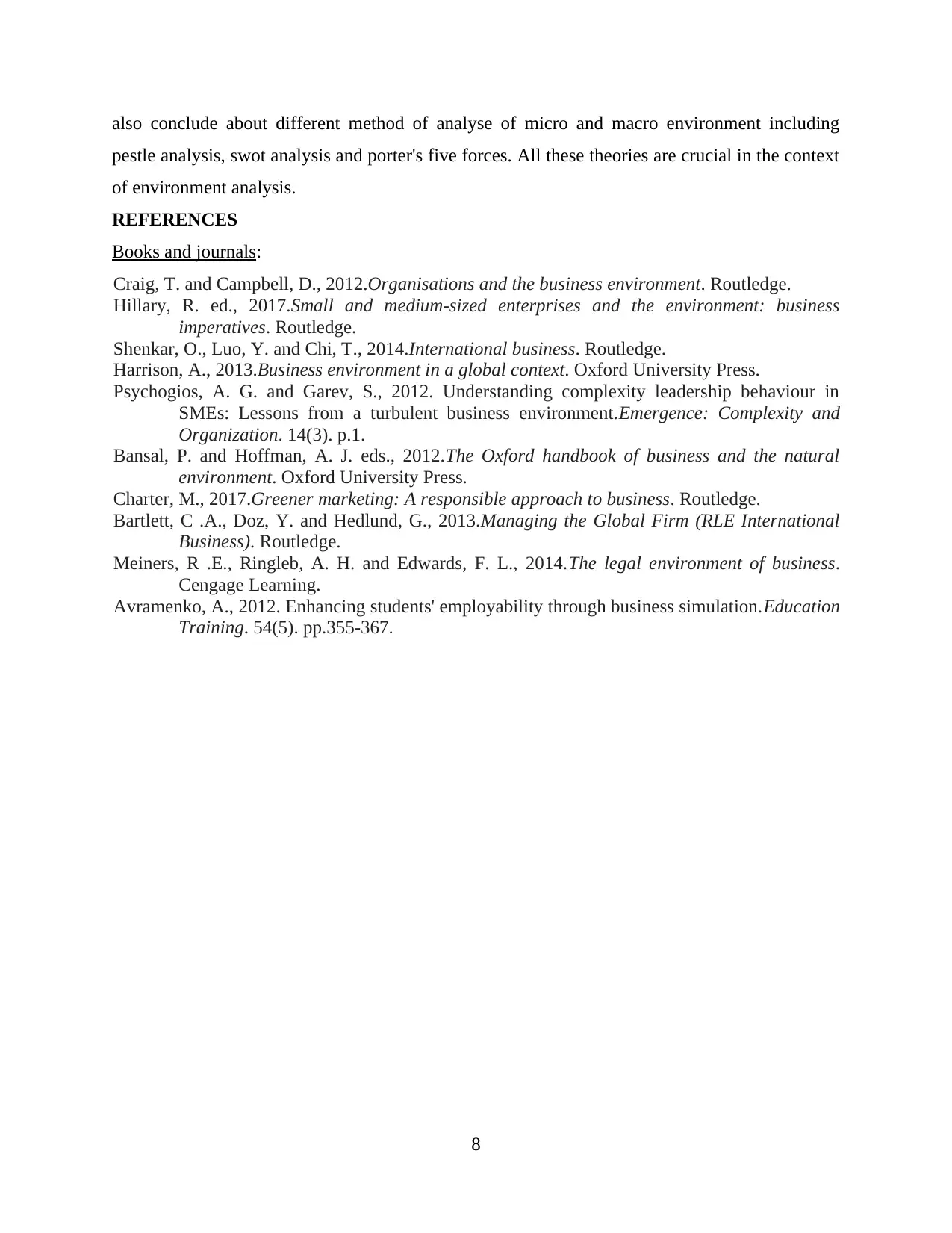
also conclude about different method of analyse of micro and macro environment including
pestle analysis, swot analysis and porter's five forces. All these theories are crucial in the context
of environment analysis.
REFERENCES
Books and journals:
Craig, T. and Campbell, D., 2012.Organisations and the business environment. Routledge.
Hillary, R. ed., 2017.Small and medium-sized enterprises and the environment: business
imperatives. Routledge.
Shenkar, O., Luo, Y. and Chi, T., 2014.International business. Routledge.
Harrison, A., 2013.Business environment in a global context. Oxford University Press.
Psychogios, A. G. and Garev, S., 2012. Understanding complexity leadership behaviour in
SMEs: Lessons from a turbulent business environment.Emergence: Complexity and
Organization. 14(3). p.1.
Bansal, P. and Hoffman, A. J. eds., 2012.The Oxford handbook of business and the natural
environment. Oxford University Press.
Charter, M., 2017.Greener marketing: A responsible approach to business. Routledge.
Bartlett, C .A., Doz, Y. and Hedlund, G., 2013.Managing the Global Firm (RLE International
Business). Routledge.
Meiners, R .E., Ringleb, A. H. and Edwards, F. L., 2014.The legal environment of business.
Cengage Learning.
Avramenko, A., 2012. Enhancing students' employability through business simulation.Education
Training. 54(5). pp.355-367.
8
pestle analysis, swot analysis and porter's five forces. All these theories are crucial in the context
of environment analysis.
REFERENCES
Books and journals:
Craig, T. and Campbell, D., 2012.Organisations and the business environment. Routledge.
Hillary, R. ed., 2017.Small and medium-sized enterprises and the environment: business
imperatives. Routledge.
Shenkar, O., Luo, Y. and Chi, T., 2014.International business. Routledge.
Harrison, A., 2013.Business environment in a global context. Oxford University Press.
Psychogios, A. G. and Garev, S., 2012. Understanding complexity leadership behaviour in
SMEs: Lessons from a turbulent business environment.Emergence: Complexity and
Organization. 14(3). p.1.
Bansal, P. and Hoffman, A. J. eds., 2012.The Oxford handbook of business and the natural
environment. Oxford University Press.
Charter, M., 2017.Greener marketing: A responsible approach to business. Routledge.
Bartlett, C .A., Doz, Y. and Hedlund, G., 2013.Managing the Global Firm (RLE International
Business). Routledge.
Meiners, R .E., Ringleb, A. H. and Edwards, F. L., 2014.The legal environment of business.
Cengage Learning.
Avramenko, A., 2012. Enhancing students' employability through business simulation.Education
Training. 54(5). pp.355-367.
8
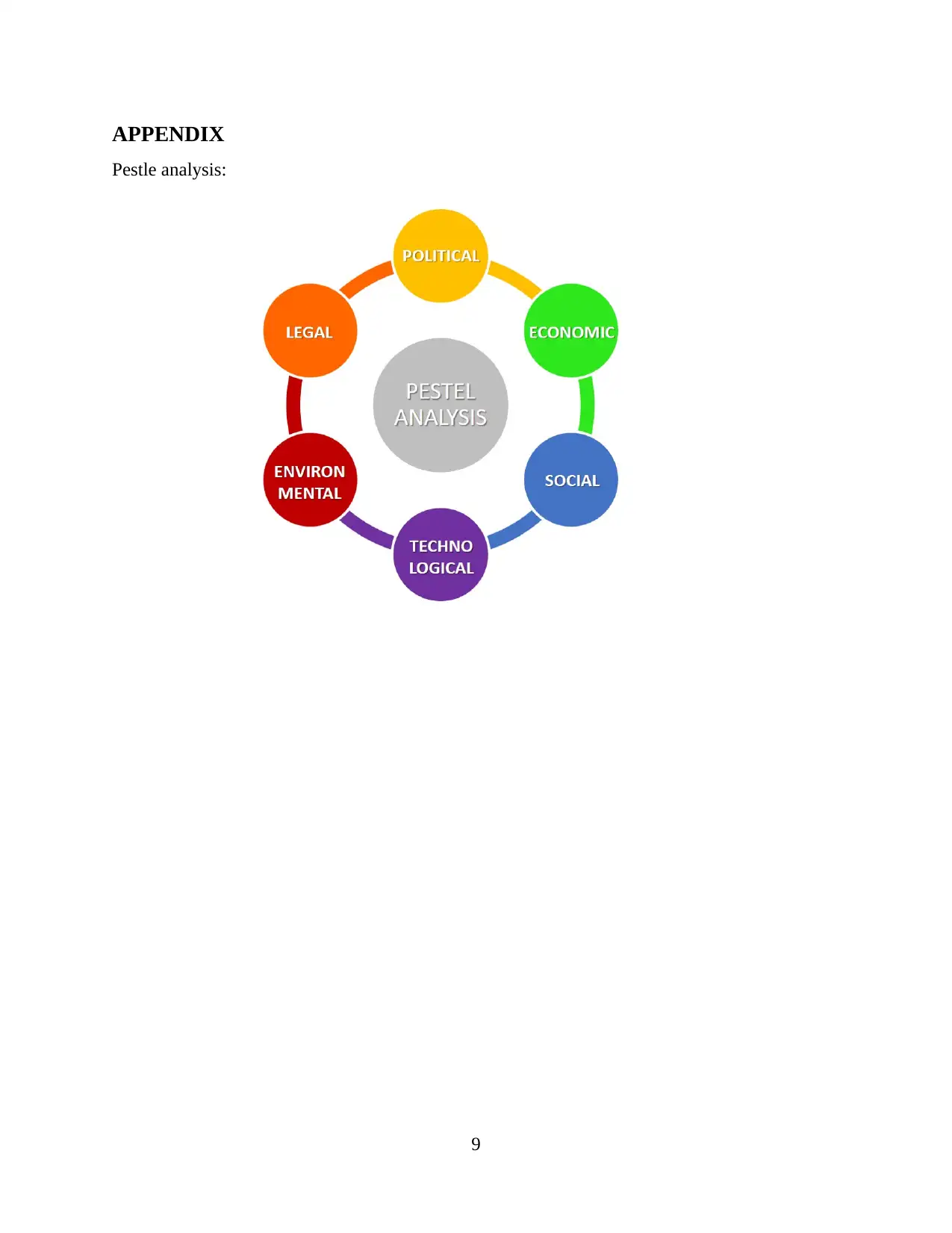
APPENDIX
Pestle analysis:
9
Pestle analysis:
9
⊘ This is a preview!⊘
Do you want full access?
Subscribe today to unlock all pages.

Trusted by 1+ million students worldwide
1 out of 14
Related Documents
Your All-in-One AI-Powered Toolkit for Academic Success.
+13062052269
info@desklib.com
Available 24*7 on WhatsApp / Email
![[object Object]](/_next/static/media/star-bottom.7253800d.svg)
Unlock your academic potential
Copyright © 2020–2025 A2Z Services. All Rights Reserved. Developed and managed by ZUCOL.





